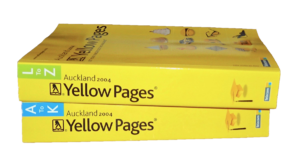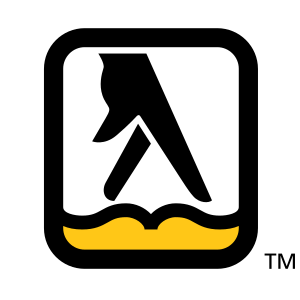Yellow pages facts for kids

2004 Yellow Pages for Auckland, New Zealand
|
|
| Parent | Various (United States), Yell (United Kingdom); Yellow Pages Group (Canada), Directories Philippines Corporation (Philippines) |
|---|---|
| Categories | Business directory |
| Frequency | Yearly |
| Publisher | Various (United States), Yell (United Kingdom); Bell Canada (Canada), Directories Philippines Corporation (Philippines) |
| Founded | 1886 |
| First issue | 1886 |
| Final issue | 2019 (United Kingdom) |
| Country | United States United Kingdom Australia Canada New Zealand Philippines |
| Based in | Various |
| Language | English |
The Yellow Pages are special telephone directories that list businesses. Unlike regular phone books that list people by name, Yellow Pages organize businesses by what they do, like "plumbers" or "pizza places." They also sell advertising space to these businesses.
These directories were first printed on yellow paper. This made them different from "white pages," which listed homes and people. Today, the term "Yellow Pages" also refers to online versions of these business directories.
In many countries, like Canada and the United Kingdom, "Yellow Pages" and its famous "Walking Fingers" logo are registered trademarks. This means only certain companies can use them. However, in the United States, anyone can use the name and logo.
Contents
History of Yellow Pages
The idea for Yellow Pages started by accident in 1883. A printer in Cheyenne, Wyoming, ran out of white paper for a phone book. He used yellow paper instead!
In 1886, a man named Reuben H. Donnelley created the first official Yellow Pages directory. Since then, the idea of "yellow pages" has spread all over the world.
Today, the term is used globally. In the United States, "yellow pages" is a general term for this type of directory. But in some other countries, "Yellow Pages" is a specific brand name. Many different companies publish Yellow Pages, both in print and online.
Print Yellow Pages usually list businesses in a certain area, like a city or town. They are grouped by the type of business. For example, all the dentists would be together. Traditionally, local phone companies published these books. Now, many different companies publish them.
Yellow Pages books are usually printed once a year. They are given out for free to homes and businesses. The publishers make money by selling ads. Businesses can buy small listings or large, colorful ads.
The Walking Fingers Logo
The famous "Walking Fingers" logo was designed by an artist named Henry Alexander in 1962. It quickly became a national symbol for Yellow Pages.
The company AT&T created the most well-known version of this logo, showing three fingers "walking." Interestingly, AT&T never officially trademarked this specific logo. They allowed any phone directory to use it. In the 1970s, TV ads showed a hand "walking" across a Yellow Pages book with the slogan, "Let Your Fingers Do the Walking."
Later, AT&T tried to trademark the logo, but they were told it was too common. It had become a general symbol for Yellow Pages, not just their company. Even so, the "walking fingers" logo is still used by many Yellow Pages publishers around the world. In some countries, like Belgium, these directories are called "Golden Pages" but still use the yellow pages logo.
Online Yellow Pages
Today, many businesses are listed in online directories. These are often called IYP, which stands for Internet Yellow Pages. They are like the print books but on the internet.
Online Yellow Pages are very popular. In 2010, "yellow pages" was one of the top search terms on Google's advertising program. This shows how many people were looking for businesses online using this term.
Internet Yellow Pages work a bit differently from regular search engines. While search engines show results based on how relevant they are, IYP often focuses on businesses in a specific local area. This helps you find services close to you. Businesses can also pay to have their listings appear higher in the search results.
Environmental Concerns
In recent years, some groups have worried about the environmental impact of printed Yellow Pages. They argue that many people no longer use the physical books, making them wasteful. Some studies showed that by 2011, nearly 70% of Americans rarely used printed phone books.
Recycling phone books can be tricky because of the type of glue used. They can sometimes clog recycling machines. However, publishers say that phone books are 100% recyclable. They are also made with eco-friendly inks and glues.
In 2011, San Francisco tried to stop giving out Yellow Pages automatically. People had to ask for them if they wanted one. This was to reduce waste. However, this rule was later changed.
To help with environmental concerns, the Yellow Pages Association created a website in 2011. This site, yellowpagesoptout.com, lets people in the United States choose not to receive printed directories.
The End of Print Directories
With more people using the internet, the need for printed Yellow Pages has gone down. In September 2017, Yell, the company that published Yellow Pages in the United Kingdom, announced a big change. They said they would stop printing the books in January 2019. This ended a 51-year tradition. The very last UK copies were sent out on January 18, 2019.
Similarly, the "Golden Pages" publisher in Ireland also moved to an online-only model in 2017. This shows a worldwide trend of moving from physical books to digital services.
Images for kids
See also
 In Spanish: Páginas amarillas para niños
In Spanish: Páginas amarillas para niños
- Blue pages – for government listings
- Electronic Yellow Pages
- List of yellow pages
- Telecommunications service
- Telephone directory (white pages) – for homes and people
- Yellowikis


